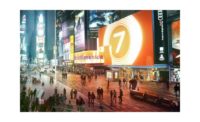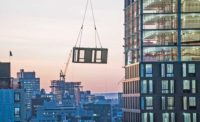When L+M Development Partners set out to create Arverne East, a master-planned community on a 116-acre vacant waterfront site on the Rockaway Peninsula in Queens, N.Y., the firm resolved to develop the first carbon net-zero community in New York City. The project already includes a 35-acre nature preserve and community center. Of its 1,650 planned housing units, 80% will be affordable. “We want to make sure that affordable housing is not left behind in the carbon transition,” says Laura Spencer Humphrey, L+M senior director of energy and sustainability.
“By designing buildings that are low energy consumption, we’re long-term protecting [L+M] and the residents.”
— Mark Ginsberg, Partner, Curtis + Ginsberg Architects
By all accounts, the New York City-based, vertically integrated affordable housing developer is sticking to that commitment. L+M will open the largest multifamily certified passive house in the U.S. this spring. The firm is on the forefront of incorporating geothermal wells into affordable housing projects. And the company recently secured the first WEDG (waterfront edge design guidelines) verification for resilient, ecological and accessible waterfronts awarded to an affordable housing project.
Low-income housing has always been an L+M priority—it has acquired, built or preserved more than 46,000 residential units in the last four decades, roughly 86% of which are affordable. More recently, however, it has expanded its focus to include climate change goals as key design and construction criteria—a deciding factor in ENR New York’s decision to select L+M as this year’s Owner of the Year.
“There’s no conversation in our room without, at least, the energy efficiency and resilience standpoint,” says Sara Levenson, a managing director on L+M’s construction team overseeing Arverne East.
Annie Tirschwell, principal at Type A Projects and a WBE partner with L+M on the 30,000-sq-ft mixed-used development in the South Bronx called Bronx Point, echoes this point. “The balance of cost and efficacy from a sustainability perspective is really a hallmark of L+M,” she says.
Sustainability Approach


L+M’s leadership team includes Lisa Gomez, CEO, and Spencer Orkus, partner and president.
Founded in 1984 by Ron Moelis and Sandy Loewentheil, L+M thrives on high-quality, affordable, mixed-income and market-rate housing that strengthens neighborhoods. In 2022, when Loewentheil retired and Moelis transitioned from CEO to chairman, Lisa Gomez was elevated to CEO from chief operating officer. The move coincided with launching LMXD, an affiliated platform designed to expand its active mixed-income and market-rate development business. The firm’s existing independent investment management business, L+M Fund Management, focuses on investing institutional capital at scale in affordable and workforce housing investments.
Mark Ginsberg—partner at Curtis + Ginsberg Architects, which has worked with L+M for 20 years—says L+M “pushes the envelope” with its commitment to community and sustainability.
Ginsberg helped L+M design its first certified passive house, a mixed-use project that opened in 2018 called Beach Green Dunes II, next to Arverne East’s site in the Rockaways. “By designing buildings that are low energy consumption, we’re long-term protecting [L+M] and the residents,” Ginsberg says of the project that also deployed L+M’s first geothermal heating and cooling system.
Levenson says Beach Green Dunes II was a “testing ground” for energy efficiency, resilience and sustainability approaches being scaled up “across the larger Arverne East parcel.”
That project, which will also have passive house residential buildings, is designed with what is believed to be one of the largest geothermal systems in the region connected to multiple buildings. “There’s not that many geothermal systems out there, especially not at the scale that we’re talking about,” Levenson says.
_ENRready.jpg)
Sendero Verde, a fully affordable development in East Harlem, will be the largest multifamily passive house in the U.S.
Rendering by Volley Studio, courtesy L+M Development Partners
One of L+M’s most impressive passive house projects is Sendero Verde, a 709-unit fully affordable development in East Harlem, which, when complete this spring, will be the largest multifamily certified passive house in the U.S.
“At the end of the day, some of the most exciting things about … any of our buildings that are passive house is how little energy they use compared to their more conventionally constructed peers,” says Humphrey. “And it’s half.”
L+M also uses passive design for high-efficiency wall assemblies, facades, roofs and windows as well as for smart site orientation. Humphrey says design is the “first line of defense” in the “hierarchy of how to decarbonize.” It boils down to “thinking about the building as a system and having an efficient envelope.”
Humphrey says another important line of defense in decarbonization is “replacement”—using onsite renewables to replace energy from the grid. “In general, we build solar on all of our new developments unless it’s not feasible because of shading or something like that,” she says.
Renewable energy will be critical to reach net zero for Arverne East, says Levenson. “The geothermal and the passive house will work from an energy efficiency standpoint to keep the loads down. But the implementation of rooftop [photovoltaic systems] is really what’s offsetting our consumption,” she points out.
While renewable energy is critical to mitigate climate change, battery backup to support a building’s entire power needs is not yet feasible, says Levenson. The developer is aiming for as much backup as possible to keep people safe. “We’re really looking at how we make sure that we have pumps running for an elevator, one amenity space or lounge in each building that has ERVs [energy recovery ventilators] for air circulation and power for a refrigerator if someone needs medicines to be refrigerated and to have one USB for charging in each unit,” she adds.
Beyond power outages, stormwater and coastal flooding are critical considerations for projects like Arverne East and Bronx Point. Open space for swale retention or rain gardens, raising ground floor entryways and lobbies, elevating mechanicals and designing for 500-year flood levels are all part of L+M’s toolkit.
“Our commitment is to our residents and making sure that they have safe and healthy places to live, and that ties a lot into resilience,” says Humphrey.
New York’s Local Law 97 has also challenged L+M. Recently implemented to limit carbon emissions for new buildings, the law forced the developer to abandon routinely installed building systems with known construction and operating costs, says Stephen Bonasera, senior vice president of preconstruction and a firm partner.
Bonasera engaged the firm’s mechanical equipment manufacturers to prototype and trial products with variable refrigerant flow technology that can fit inside windows. Bonasera says the vertically integrated firm ultimately benefits from the upgrades as “we’re always thinking about actually building out buildings to be more efficient because ultimately, we’re paying the bills to operate the building.”
Notable L+M Projects Include:
Arverne East, a master-planned community that is revitalizing a vacant 116-acre oceanfront site on the Rockaway Peninsula in Queens. Its first phase includes a 35-acre nature preserve, a welcome center and a community center. When completed by 2031, the development will feature 1,650 units of housing, including affordable, market rate and homeownership opportunities. The net-zero project is positioned to become one of the most environmentally conscious developments in the country.
Sendero Verde, a 709-unit, fully affordable development in East Harlem that will be the largest multifamily passive house in the U.S. It includes a community center, school and more than 11,500 sq ft of community gardens. The first completed phase features 361 affordable housing units for households ranging from very low to moderate income as well as the formerly homeless. Sendero Verde’s second phase, in its final phases of construction and set to open this spring, includes a 34-story tower with 348 units.
Bronx Point, a 530,000-sq-ft mixed-use development in the South Bronx along the Harlem River that includes 542 units of permanently affordable housing, a youth education space, public waterfront park and retail opportunities. It is the first affordable housing project to receive the WEDG standard for waterfront resilience and risk reduction. The housing and public space components opened in October 2023.
A Deluge of Standards
The housing sector has received a deluge of new green building rating systems, from EnergyStar’s net-zero standards to updated LEED Certification and more. L+M’s goal is to sort out what makes the most sense for each building, and it “isn’t the same in every project,” says Humphrey.
“I think we’re also trying to look at what these rating systems are teaching us about actual performance now that we have a couple of years of performance under our belts with these really advanced buildings,” she says.
Bonasera thinks it’s important that government be “forward-thinking” in its vision and standards, but “when there’s a change so dramatic … it really affects ownership, design consultants, district contractors, subcontractors and the level of training.”
Ginsberg says L+M finds ways to adapt to changes—especially from a building operations perspective—using a “holistic approach” that involves cycles of feedback and discussion. “As we’re designing, they’re critiquing.”
Someday there may be more standards, such as sourcing products with low-embodied carbon. L+M says it is in the early stages of thinking through alternative materials.
“In terms of the broader materials [selection], I think we and all of our counterparts are trying to figure out the right way into this, since it’s not as simple as just swapping one thing for another,” says Humphrey.
While L+M doesn’t pursue certifications for every project, the firm hopes to continue to clarify its own sustainability vision “to establish what our threshold is, our baseline, such as we always achieve ‘x,’” says Humphrey.
The authenticity of this approach stands out to Type A Projects partner Tirschwell. L+M does not “do things just so that they can slap [on] a label,” she says.




Post a comment to this article
Report Abusive Comment